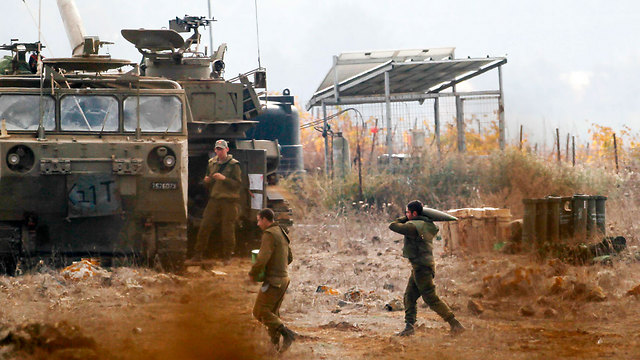
The old agreement that will keep Iran away from Israeli border
Analysis: Why is the State of Israel disrupting the Syrian army’s efforts to defend Druze village of Hader, which Israel itself has vowed to protect? Because Syrians are building posts within the Golan Heights buffer zone in violation of 1974 Disengagement Agreement, which is seen today an important deterring and legal tool against Iran and Hezbollah.
For the second day in a row, an Israeli tank fired a warning shell at a Syrian force building a post to protect the Druze village of Hader from the al-Nusra Front organization that has been threatening the village.
Seemingly, the IDF and the Syrian force building the fortifications west of the village have the exact same goal—to defend the Druze living in the village. Al-Nusra Front militants, who are affiliated with al-Qaeda, tried to occupy the village from that direction a little over a week ago. They even got a car bomb into the village, killing nine Syrian Druze in its explosion.
The post being built by the Syrian army aims to block that route of attack. Israel has also vowed to protect the Syrian Druze in the village of Hader, because of the State of Israel’s alliance with its Druze citizens. So why is the State of Israel disrupting the Syrian army’s efforts to defend the Druze, even forcibly preventing this protection?
The answer is that the Syrians are building the new fortified space within the buffer zone between the two disengagement lines—the Syrian and the Israeli—in the Golan Heights. The 1974 Disengagement Agreement, which was signed after the Yom Kippur War, bars the Syrian army from entering that area and setting up posts there. When the Syrian army built a post on the eastern side of the village of Hader, Israel didn’t say a thing, because that area is located on Syrian territory and not within the buffer zone.
The Syrians are building the new posts within the buffer zone, prompting Israel to fire warning shots despite the fact these posts actually serve the security of the residents of the village Israel officially vowed to protect. This is just one of many absurdities characterizing the Middle Eastern arena, and the reason for this absurdity is that Israel—today more than ever—is unwilling to accept even the tiniest violation of the Disengagement Agreement signed 43 years ago.
Against Israel’s immediate interests
The 1974 agreement is the oldest agreement between Israel and Arab states that is still honored by both sides. Now, the agreement has become much more important for Israel than it has been in the past 20 years, in light of the attempts made by the Iranians and Hezbollah to get their people—primarily armed militias—into the Syrian Golan Heights, and particularly into the area close to the disengagement line. Israel has already announced it won’t allow it, and the Disengagement Agreement provides a legal and international basis for that.
The Disengagement Agreement includes not only a buffer zone along several kilometers. There are also dilution-of-forces strips on both sides of the buffer zone, where both the IDF and the Syrians are not allowed to keep armed forces beyond a limited amount. In the buffer zone, it is strictly forbidden to keep military forces, which is why there are no Syrian forces and no IDF forces between the two disengagement lines. Today, there are only rebels there.
There is a dilution strip on both sides of the buffer zone where the IDF and the Syrian army are allowed to keep 75 tanks and 6,000 soldiers. Beyond the first dilution strip there is a second strip, where each side is allowed to keep 450 tanks, but its location is more than 20 kilometers from the disengagement line on each side.
In practice, if the Iranians try to keep their own forces—for example, Hezbollah or Shiite militias or even Revolutionary Guard soldiers—less than 20 kilometers from the border with Israel, it would be seen as a violation of the Disengagement Agreement, which is being supervised by the United Nations Disengagement Observer Force. The Russians would see it right away, and so would the Americans and the UN.
So although this slightly contradicts its immediate interests, Israel is making it clear it won’t allow the Syrian regime to protect Hader at the cost of violating the Disengagement Agreement, which is seen today an important deterring and legal tool against the Iranians and Hezbollah.












